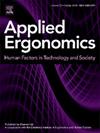基于美发师新工具整合过程中的平滑度评估运动技能进步
IF 3.4
2区 工程技术
Q2 ENGINEERING, INDUSTRIAL
引用次数: 0
摘要
技能获取传统上是基于生产力度量来评估的,例如反映任务执行速度的移动时间(MT)。然而,通过评估动作执行的改进,动作流畅度可以为技能进步提供额外的见解。本研究评估了随着工具的改变,美发的平滑度和生产力的演变。14名专业发型师,即无环剪刀的新手用户,在实验室进行了为期4个半月的初始使用和在发廊使用4.5个月后的动态记录。先用传统剪刀[TS],再用RS进行三种类型的切割。测井无量纲推力;光谱弧长(SPARC)]评估了一个基本的运动序列,从刀具运输到切割开始。MT,代表这些序列的持续时间,被评估为生产力的衡量标准。引入RS后,平滑度降低,MT增加。经过练习,这两个特点都得到了改善。训练后,三种切割动作中有两种的SPARC在RS和TS中显示出相当的平滑度,而LDLJ和NoP在TS中仍然较高。4.5个月后,平滑度进一步提高,LDLJ和NoP接近TS值。虽然MT显著降低,但在美容院使用4.5个月后,RS的MT仍然高于TS。这些结果表明,新工具的引入不仅影响生产率- MT -而且影响运动质量-平滑度。本研究的结果强调了在涉及运动学习的职业背景下平滑度测量的相关性。本文章由计算机程序翻译,如有差异,请以英文原文为准。
Assessing motor skill progression based on smoothness during integration of a new tool among hairdressers
Skill acquisition is traditionally assessed based on productivity measures, such as Movement Time (MT), which reflect task execution speed. However, movement smoothness may provide additional insights into skill progression by assessing improvements in movement execution. This study evaluated the evolution of both smoothness and productivity in hairdressing following a change of tool. Kinematic recordings of 14 professional hairdressers, novice users of Ringless Scissors [RS], were taken in the laboratory over four half-days of initiation and after 4.5 months of use in the hair salon. Three types of cuts were performed with Traditional Scissors [TS], then with RS. Smoothness [Number of Peaks (NoP); Log DimensionLess Jerk (LDLJ); SPectral ARC length (SPARC)] was assessed for an elementary movement sequence, spanning tool transport to the start of cutting. MT, representing the duration of these sequences, was assessed as a measure of productivity. After introduction of the RS, smoothness decreased and MT increased. With practice, both characteristics improved. After training, SPARC showed comparable smoothness between RS and TS for two of three cutting movements, while LDLJ and NoP remained higher with TS. After 4.5 months, smoothness improved further, with LDLJ and NoP approaching TS values. Although MT was significantly reduced, it remained higher with RS than TS after 4.5 months use in the salon. These results suggest that introduction of a new tool affects not only productivity – MT – but also movement quality – smoothness. The results presented highlight the relevance of smoothness measures in occupational contexts involving motor learning.
求助全文
通过发布文献求助,成功后即可免费获取论文全文。
去求助
来源期刊

Applied Ergonomics
工程技术-工程:工业
CiteScore
7.50
自引率
9.40%
发文量
248
审稿时长
53 days
期刊介绍:
Applied Ergonomics is aimed at ergonomists and all those interested in applying ergonomics/human factors in the design, planning and management of technical and social systems at work or leisure. Readership is truly international with subscribers in over 50 countries. Professionals for whom Applied Ergonomics is of interest include: ergonomists, designers, industrial engineers, health and safety specialists, systems engineers, design engineers, organizational psychologists, occupational health specialists and human-computer interaction specialists.
 求助内容:
求助内容: 应助结果提醒方式:
应助结果提醒方式:


